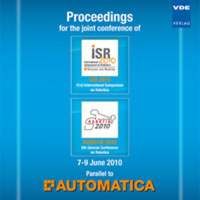A Uniform Framework to Program, Animate and Control Objects, Kinematics and Articulated Mechanisms in a Comprehensive Simulation System
Conference: ISR/ROBOTIK 2010 - ISR 2010 (41st International Symposium on Robotics) and ROBOTIK 2010 (6th German Conference on Robotics)
06/07/2010 - 06/09/2010 at Munich, Germany
Proceedings: ISR/ROBOTIK 2010
Pages: 7Language: englishTyp: PDF
Personal VDE Members are entitled to a 10% discount on this title
Authors:
Roßmann, Jürgen; Schlette, Christian; Schluse, Michael (MMI, Aachen, Germany)
Eilers, Kevin (RIF e.V., Dortmund, Germany)
Abstract:
In this paper, we present a uniform framework and versatile data structure to program, animate and control objects, kinematics and articulated mechanisms in a comprehensive simulation and Virtual Reality system. Such a system has demanding requirements regarding framework and data structures on which the performance and the capabilities of the applications depend. We decided for a scene graph based structure with the ability to augment its nodes with arbitrary data to represent additional functional and structural information. This approach - though it utilizes a simple graph at its core - is highly modular and versatile in representing a broad range of kinematic relations and allows for various applications in the field of simulation and VR. Currently, such diverse areas as forest harvesting processes, advanced production environments, and mechanisms on the International Space Station are covered by our simulation system and its database. As examples of the versatility of this approach, we describe the adaption of the scene graph for the description of kinematic trees. We also present methods for describing targets and paths in Cartesian and in joint coordinates in the simulated world which - in co-operation with the kinematics - offer a powerful tool for controlling complex kinematic mechanisms. Finally, the capabilities of the framework are highlighted by examples of how objects seemingly unrelated to the simulation, like a camera depicting the simulated scene, can be controlled with the same methods as kinematic mechanisms.


